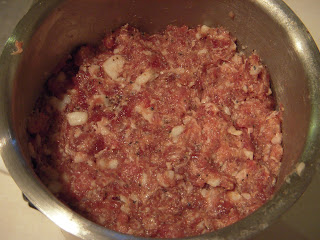Finding this kind of clinched my decision for trying my hand at some wild boar salame or, salame di cinghiale as it is called in Italy where wild boar is not an uncommon ingredient, (especially in the central regions of Italy).
One of the things I came across while referring to various recipes was that you could freeze the boar for up to three days to ward off Trichinosis. Trichinosis is a parasite that you can get by eating undercooked or raw pork (usually home reared, and fed raw meat) and wild game. I won't get into the specifics of this factoid, partly because I'm not qualified and mostly because it detracts from the point of this blog, but if you are curious, the internet is an amazing thing with some amazing and graphic pictures. Anyway, I'll start talking about the process of making Cinghiale di Salame now...
You'll notice the color is much more red than regular pork shoulder. Here it is again with the pork and fatback.
The rest of the steps are basically identical to making any salame or fresh sausage except for the addition of cure#2 in salame and the specific spices you want to use. Here is my spice mixture. I kept this one very simple in order to showcase the flavor of the boar, just salt, cure, black pepper and garlic.
Rub your spices and salt into the pork before it is ground and the put it in the freezer for at least a half hour.
I only ground this once this time, with the large die for the Kitchenaid grinder attachment. I wanted a lumpier, more rustic mouth feel with larger bits of fat.
Next is to incorporate some kind of wine. I've been tasting different Italian wines lately, mostly ones made with grapes indigenous to southern Italy. This grape, Aglianico, comes from the region of Campania, home to Naples and the Amalfi coast. It is a very popular grape in Campania though, not as popular here in the states at least not in PA wine and spirits stores where the majority of red wine found in the Italian section are various Chianti. I had to go to a wine and spirits positioned in one of the wealthier towns near me to find a wine with this grape and they only had one producer. This one has a DOC or Denominazione di Origine Controllata, designation which translates into "controlled place of named origin. DOCG, DOC, IGT, and Vino da Tavola, are all wine classifications that wines and vineyards can get in Italy that regulate and specify the type of grape used, the region, the age and other factors to ensure a quality authentic product. I won't get into wine too much as I don't know enough about it yet but there are plenty of sources to acquire knowledge from on the subject if you are interested.
Luckily I enjoyed the flavor very much, very dry with a little kick, almost like the homemade wine I have tried but without the usual grape juice or dirty taste that usually accompanies homemade wine. I guess basically it was that almost harsh after taste that it had that made me think of the homemade stuff. But all in all I liked it and thought it would make a good pairing with the boar. Anyway, I poured a little more than half a cup of this wine into the meat mixture, then mixed with my hands till it was fully incorporated into the meat.
The rest of this process I have shown a couple times now but I'll give you a brief pictorial of the process. The casings are synthetic again (a lot less prep work). Here's the meat in the stuffing canister.
And the stuffing.
That about sums it up. Keep checking back for more posts and I'd be happy to answer any questions I can so don't be afraid to leave a comment or two. Thanks again!












No comments:
Post a Comment